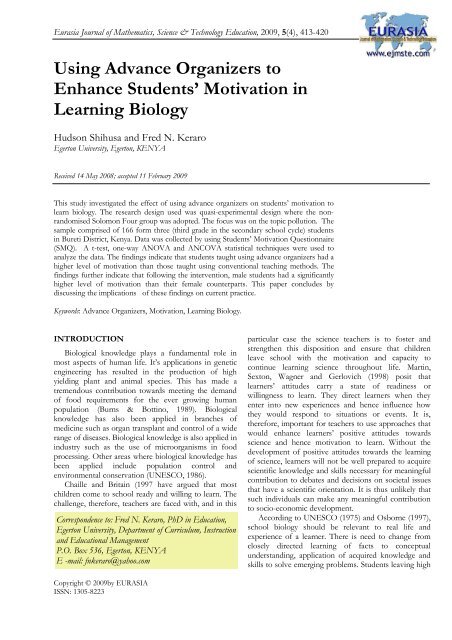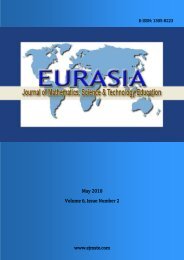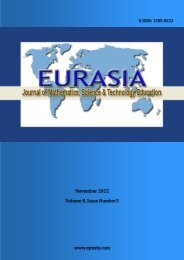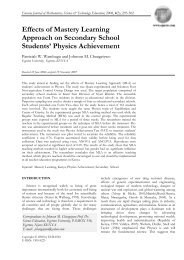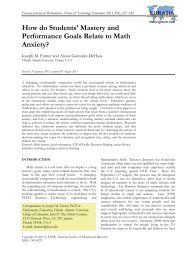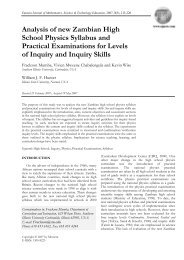Using Advance Organizers to Enhance Students' Motivation in ...
Using Advance Organizers to Enhance Students' Motivation in ...
Using Advance Organizers to Enhance Students' Motivation in ...
Create successful ePaper yourself
Turn your PDF publications into a flip-book with our unique Google optimized e-Paper software.
Eurasia Journal of Mathematics, Science & Technology Education, 2009, 5(4), 413-420<br />
<strong>Us<strong>in</strong>g</strong> <strong>Advance</strong> <strong>Organizers</strong> <strong>to</strong><br />
<strong>Enhance</strong> Students’ <strong>Motivation</strong> <strong>in</strong><br />
Learn<strong>in</strong>g Biology<br />
Hudson Shihusa and Fred N. Keraro<br />
Eger<strong>to</strong>n University, Eger<strong>to</strong>n, KENYA<br />
Received 14 May 2008; accepted 11 February 2009<br />
This study <strong>in</strong>vestigated the effect of us<strong>in</strong>g advance organizers on students’ motivation <strong>to</strong><br />
learn biology. The research design used was quasi-experimental design where the nonrandomised<br />
Solomon Four group was adopted. The focus was on the <strong>to</strong>pic pollution. The<br />
sample comprised of 166 form three (third grade <strong>in</strong> the secondary school cycle) students<br />
<strong>in</strong> Bureti District, Kenya. Data was collected by us<strong>in</strong>g Students’ <strong>Motivation</strong> Questionnaire<br />
(SMQ). A t-test, one-way ANOVA and ANCOVA statistical techniques were used <strong>to</strong><br />
analyze the data. The f<strong>in</strong>d<strong>in</strong>gs <strong>in</strong>dicate that students taught us<strong>in</strong>g advance organizers had a<br />
higher level of motivation than those taught us<strong>in</strong>g conventional teach<strong>in</strong>g methods. The<br />
f<strong>in</strong>d<strong>in</strong>gs further <strong>in</strong>dicate that follow<strong>in</strong>g the <strong>in</strong>tervention, male students had a significantly<br />
higher level of motivation than their female counterparts. This paper concludes by<br />
discuss<strong>in</strong>g the implications of these f<strong>in</strong>d<strong>in</strong>gs on current practice.<br />
Keywords: <strong>Advance</strong> <strong>Organizers</strong>, <strong>Motivation</strong>, Learn<strong>in</strong>g Biology.<br />
INTRODUCTION<br />
Biological knowledge plays a fundamental role <strong>in</strong><br />
most aspects of human life. It’s applications <strong>in</strong> genetic<br />
eng<strong>in</strong>eer<strong>in</strong>g has resulted <strong>in</strong> the production of high<br />
yield<strong>in</strong>g plant and animal species. This has made a<br />
tremendous contribution <strong>to</strong>wards meet<strong>in</strong>g the demand<br />
of food requirements for the ever grow<strong>in</strong>g human<br />
population (Burns & Bott<strong>in</strong>o, 1989). Biological<br />
knowledge has also been applied <strong>in</strong> branches of<br />
medic<strong>in</strong>e such as organ transplant and control of a wide<br />
range of diseases. Biological knowledge is also applied <strong>in</strong><br />
<strong>in</strong>dustry such as the use of microorganisms <strong>in</strong> food<br />
process<strong>in</strong>g. Other areas where biological knowledge has<br />
been applied <strong>in</strong>clude population control and<br />
environmental conservation (UNESCO, 1986).<br />
Chaille and Brita<strong>in</strong> (1997 have argued that most<br />
children come <strong>to</strong> school ready and will<strong>in</strong>g <strong>to</strong> learn. The<br />
challenge, therefore, teachers are faced with, and <strong>in</strong> this<br />
Correspondence <strong>to</strong>: Fred N. Keraro, PhD <strong>in</strong> Education,<br />
Eger<strong>to</strong>n University, Department of Curriculum, Instruction<br />
and Educational Management<br />
P.O. Box 536, Eger<strong>to</strong>n, KENYA<br />
E -mail: fnkeraro@yahoo.com<br />
particular case the science teachers is <strong>to</strong> foster and<br />
strengthen this disposition and ensure that children<br />
leave school with the motivation and capacity <strong>to</strong><br />
cont<strong>in</strong>ue learn<strong>in</strong>g science throughout life. Mart<strong>in</strong>,<br />
Sex<strong>to</strong>n, Wagner and Gerlovich (1998) posit that<br />
learners’ attitudes carry a state of read<strong>in</strong>ess or<br />
will<strong>in</strong>gness <strong>to</strong> learn. They direct learners when they<br />
enter <strong>in</strong><strong>to</strong> new experiences and hence <strong>in</strong>fluence how<br />
they would respond <strong>to</strong> situations or events. It is,<br />
therefore, important for teachers <strong>to</strong> use approaches that<br />
would enhance learners’ positive attitudes <strong>to</strong>wards<br />
science and hence motivation <strong>to</strong> learn. Without the<br />
development of positive attitudes <strong>to</strong>wards the learn<strong>in</strong>g<br />
of science, learners will not be well prepared <strong>to</strong> acquire<br />
scientific knowledge and skills necessary for mean<strong>in</strong>gful<br />
contribution <strong>to</strong> debates and decisions on societal issues<br />
that have a scientific orientation. It is thus unlikely that<br />
such <strong>in</strong>dividuals can make any mean<strong>in</strong>gful contribution<br />
<strong>to</strong> socio-economic development.<br />
Accord<strong>in</strong>g <strong>to</strong> UNESCO (1975) and Osborne (1997),<br />
school biology should be relevant <strong>to</strong> real life and<br />
experience of a learner. There is need <strong>to</strong> change from<br />
closely directed learn<strong>in</strong>g of facts <strong>to</strong> conceptual<br />
understand<strong>in</strong>g, application of acquired knowledge and<br />
skills <strong>to</strong> solve emerg<strong>in</strong>g problems. Students leav<strong>in</strong>g high<br />
Copyright © 2009by EURASIA<br />
ISSN: 1305-8223
H. Shihusa & F. N. Keraro<br />
schools should be able <strong>to</strong> apply scientific knowledge<br />
learned and solve some of the problems encountered <strong>in</strong><br />
everyday life (Rose, 1971). Nelson (2000) posits that<br />
there is a relationship between motivation, cognitive<br />
engagement and conceptual change. An effective<br />
teach<strong>in</strong>g approach should, therefore, utilize a wide<br />
variety of teach<strong>in</strong>g methods <strong>to</strong> enhance learners’<br />
motivation and actively <strong>in</strong>volve them <strong>in</strong> the learn<strong>in</strong>g<br />
process. Exposi<strong>to</strong>ry approaches cannot stand up <strong>to</strong> the<br />
challenges of the new demands and objectives of<br />
biology education hence the need <strong>to</strong> explore new<br />
teach<strong>in</strong>g approaches (UNESCO, 1986). Teach<strong>in</strong>g<br />
approaches that actively <strong>in</strong>volve learners would likely<br />
lead <strong>to</strong> higher motivation and mean<strong>in</strong>gful learn<strong>in</strong>g<br />
compared <strong>to</strong> those where they rema<strong>in</strong> passive.<br />
UNESCO suggests <strong>in</strong>clud<strong>in</strong>g teach<strong>in</strong>g approaches<br />
which are <strong>in</strong>quiry/discovery based and which requires<br />
some form of problem solv<strong>in</strong>g. These approaches have<br />
the capacity <strong>to</strong> motivate learners and actively <strong>in</strong>volve<br />
them <strong>in</strong> the learn<strong>in</strong>g process.<br />
Mills (1991) argues that a teach<strong>in</strong>g approach that a<br />
teacher adopts is a strong fac<strong>to</strong>r that may affect a<br />
learner’s motivation <strong>to</strong> learn and hence has a direct<br />
impact on the resultant cognitive ga<strong>in</strong>. In recent years,<br />
science educa<strong>to</strong>rs have used the constructivist approach<br />
<strong>to</strong> enhance students’ learn<strong>in</strong>g (Trowbridge, Bybee &<br />
Powell, 2004). Accord<strong>in</strong>g <strong>to</strong> Good and Brophy (1995),<br />
<strong>in</strong> constructivist teach<strong>in</strong>g, learners are seen not just as<br />
access<strong>in</strong>g <strong>in</strong>formation but also as construct<strong>in</strong>g mean<strong>in</strong>g.<br />
Aslop and Hicks (2001) po<strong>in</strong>t out that learn<strong>in</strong>g of<br />
science is essentially an active process. Keraro,<br />
Wachanga and Orora (2007) conducted a study <strong>to</strong><br />
<strong>in</strong>vestigate the effects of cooperative concept mapp<strong>in</strong>g<br />
(CCM) teach<strong>in</strong>g approach on secondary school<br />
students’ motivation <strong>to</strong> learn biology. Their f<strong>in</strong>d<strong>in</strong>gs<br />
<strong>in</strong>dicate that the CCM teach<strong>in</strong>g approach significantly<br />
enhanced students’ motivation <strong>to</strong> learn as students are<br />
actively engaged dur<strong>in</strong>g the <strong>in</strong>structional process. Tella<br />
(2007) also adds his voice <strong>to</strong> this debate. He asserts that<br />
of all the personal and psychological variables that have<br />
attracted researchers <strong>in</strong> educational achievement,<br />
motivation seems <strong>to</strong> be ga<strong>in</strong><strong>in</strong>g more popularity and<br />
lead<strong>in</strong>g other variables.<br />
Academic motivation is the psychological process<br />
that determ<strong>in</strong>es the direction, <strong>in</strong>tensity and persistence<br />
of behaviour related <strong>to</strong> learn<strong>in</strong>g (Husen &<br />
Postelthwaite, 1991). Beihler and Snowman (1997) argue<br />
that motivation determ<strong>in</strong>es arousal, selection, direction<br />
and cont<strong>in</strong>uation of learner’s behaviour. <strong>Motivation</strong> is a<br />
crucial component <strong>in</strong> learn<strong>in</strong>g and it is critical <strong>in</strong><br />
determ<strong>in</strong><strong>in</strong>g achievement of students (Spr<strong>in</strong>thall &<br />
Spr<strong>in</strong>thall, 1990; Hemke, 1990). <strong>Motivation</strong> of learners<br />
is one of the most important fac<strong>to</strong>rs <strong>in</strong> teach<strong>in</strong>g. As<br />
Kochhar (1992) states, without it, there can be no<br />
learn<strong>in</strong>g and with it, learners cannot be prevented from<br />
learn<strong>in</strong>g. This idea is concured by Slav<strong>in</strong> (1997) when he<br />
posits that students’ motivation is an <strong>in</strong>ternal process<br />
that activates guides and ma<strong>in</strong>ta<strong>in</strong>s learners behaviour<br />
over time and will also propel and direct them <strong>to</strong> engage<br />
<strong>in</strong> learn<strong>in</strong>g activities. A motivated student is, therefore,<br />
one who has <strong>in</strong>ner state that energizes channels and<br />
ma<strong>in</strong>ta<strong>in</strong>s his/her behaviour and directs it <strong>to</strong> some<br />
desired need or goal (De Cecco & Crawford, 1988).<br />
Use of advance organizers <strong>in</strong> learn<strong>in</strong>g<br />
An advance organizer is a k<strong>in</strong>d of cognitive bridge,<br />
which teachers use <strong>to</strong> help learners make a l<strong>in</strong>k between<br />
what they know and what is <strong>to</strong> be learnt (Novak, 1980).<br />
<strong>Advance</strong> organizers can refer <strong>to</strong> a relatively short<br />
arrangement of material <strong>in</strong>troduced <strong>to</strong> the learner before<br />
the lesson. It is designed <strong>to</strong> cue the relevant prior<br />
knowledge of a learner and it is usually presented at a<br />
higher level of abstraction, generality and <strong>in</strong>clusiveness<br />
than that of the planned lesson (Curzon, 1990).<br />
<strong>Advance</strong> organizers are therefore frameworks that<br />
enable students learn new ideas or <strong>in</strong>formation and<br />
mean<strong>in</strong>gfully l<strong>in</strong>k these ideas <strong>to</strong> the exist<strong>in</strong>g cognitive<br />
structure.<br />
Accord<strong>in</strong>g <strong>to</strong> Ausubel (1960), an advance organizer<br />
is a material that is <strong>in</strong>troduced before an unfamiliar<br />
content so as <strong>to</strong> facilitate its assimilation. They,<br />
therefore, act as an anchor for the reception of new<br />
content (Ausubel, 1963). Ausubel further po<strong>in</strong>ts out that<br />
cognitive restructur<strong>in</strong>g process that is as a result of<br />
advance organizers leads <strong>to</strong> some positive learn<strong>in</strong>g<br />
outcome. In this study, a film, a chart and text handouts<br />
on pollution were used as a bridge <strong>to</strong> help learners l<strong>in</strong>k<br />
between what they knew about pollution and what was<br />
<strong>to</strong> be learnt.<br />
Types of advance organizers<br />
There are two broad categories of advance<br />
organizers. One of them is “Exposi<strong>to</strong>ry organizers’<br />
which are used whenever the new material is <strong>to</strong>tally<br />
unfamiliar; they emphasize context and l<strong>in</strong>k the essence<br />
of the new material with some relevant previously<br />
acquired concepts. The other one is “Comparative<br />
organizers” which are used when the material <strong>to</strong> be<br />
learnt is not entirely new. They are <strong>in</strong>tended <strong>to</strong> po<strong>in</strong>t out<br />
ways <strong>in</strong> which that material resembles and differs from<br />
that which is already known (Curzon, 1990).<br />
Accord<strong>in</strong>g <strong>to</strong> Novak (1980), advance organizers<br />
would <strong>in</strong>clude analogy, metaphor, model or capsule of<br />
knowledge as well as concept maps. Graphic organizers<br />
provide a visual holistic representation of facts and<br />
concepts and their relationships with<strong>in</strong> an organized<br />
frame. They exist <strong>in</strong> a variety of forms which <strong>in</strong>clude<br />
sequence cha<strong>in</strong>, s<strong>to</strong>ry map, ma<strong>in</strong> idea table, flow charts,<br />
matrix and venn diagrams (Anders, Bos & Filip, 1984).<br />
Graphic organizers may be productively utilized before<br />
414 © 2009 EURASIA, Eurasia J. Math. Sci. & Tech. Ed.,5(3), 413-420
Students’ <strong>Motivation</strong> <strong>in</strong> Learn<strong>in</strong>g Biology<br />
<strong>in</strong>structional activities such as read<strong>in</strong>g or view<strong>in</strong>g a film,<br />
<strong>to</strong> activate prior knowledge <strong>to</strong> provide a conceptual<br />
framework for <strong>in</strong>tegrat<strong>in</strong>g new <strong>in</strong>formation and<br />
encourage student prediction. Dur<strong>in</strong>g <strong>in</strong>struction, they<br />
can help students <strong>to</strong> actively process and re-organize<br />
<strong>in</strong>formation. Novak (1980) asserts that creative<br />
teach<strong>in</strong>g, when well done, <strong>in</strong>cludes the selection and use<br />
of good advance organizers. In this study a film, a chart<br />
(exposi<strong>to</strong>ry advance organizers) and text handouts<br />
(comparative advance organizer) on environmental<br />
pollutions were the advance organizers. The film was <strong>in</strong><br />
three sections which covered water, land, air pollution<br />
and their causes. The chart covered the effects and<br />
control measures of water, land and air pollution. The<br />
handouts covered radioactive and noise pollution, their<br />
effects and possible control measures. All the advance<br />
organizers were presented <strong>to</strong> learners before actual<br />
classroom <strong>in</strong>struction <strong>to</strong>ok place.<br />
Effects of the use of advance organizers on learn<strong>in</strong>g<br />
Research <strong>in</strong><strong>to</strong> the use of advance organizers suggests<br />
that they are of considerable value where the learner<br />
may not be able <strong>to</strong> recognize his or her prior knowledge<br />
as relevant and where the teacher wishes <strong>to</strong> focus<br />
students’ attention on relationships among l<strong>in</strong>ked parts<br />
of an idea and on connections between parts and the<br />
whole (Curzon, 1990). Curzon further po<strong>in</strong>ts out that<br />
Ausubel's own research suggests that the use of advance<br />
organizers can enhance the relationship between<br />
cognitive structure and new material, thus facilitat<strong>in</strong>g<br />
teach<strong>in</strong>g and learn<strong>in</strong>g. A study by Nyabwa (2005) has<br />
demonstrated the effectiveness of us<strong>in</strong>g advance<br />
organizers <strong>in</strong> the teach<strong>in</strong>g of mathematics <strong>in</strong> secondary<br />
schools. Their merit <strong>in</strong> facilitat<strong>in</strong>g mean<strong>in</strong>gful learn<strong>in</strong>g<br />
of exposi<strong>to</strong>ry materials has been recorded by Allen<br />
(1970); Law<strong>to</strong>n & Wasnaka (1977). White and Tisher<br />
(1986) presented evidence suggest<strong>in</strong>g that students who<br />
lack relevant prior knowledge are most likely <strong>to</strong> benefit<br />
from the use of advance organizers and that this may<br />
expla<strong>in</strong> the contradictions among studies.<br />
Weil and Murphy (1982), assert that use of an<br />
advance organizer is a highly effective <strong>in</strong>structional<br />
strategy for all subject areas where the objective is <strong>to</strong><br />
achieve mean<strong>in</strong>gful assimilation of concepts. Accord<strong>in</strong>g<br />
<strong>to</strong> Mayer (1979), advance organizers have positive but<br />
conditional effects on learn<strong>in</strong>g. Mayer further suggests<br />
that the most effective advance organizers are those<br />
that:<br />
Allow the students <strong>to</strong> generate all or most of the logical<br />
relationships <strong>in</strong> the material <strong>to</strong> be learnt.<br />
Po<strong>in</strong>t out relationships between familiar and less familiar<br />
material.<br />
Are relatively simple <strong>to</strong> learn, and<br />
Are used <strong>in</strong> situations <strong>in</strong> which the learner would not<br />
spontaneously use them.<br />
As a result of this view it can be concluded that<br />
advance organizers have a positive <strong>in</strong>fluence on learn<strong>in</strong>g<br />
outcomes. A study by Willerman and Mac Harg (1992)<br />
<strong>in</strong>vestigated the effects of advance organizers on<br />
students’ conceptualization of pollution <strong>in</strong> biology. In<br />
this study concept mapp<strong>in</strong>g was used as an advance<br />
organizer. The f<strong>in</strong>d<strong>in</strong>gs of this study revealed that<br />
students are not passive subjects <strong>in</strong> the learn<strong>in</strong>g process<br />
if they use concept mapp<strong>in</strong>g as an advance organizer.<br />
These f<strong>in</strong>d<strong>in</strong>gs, therefore, make a contribution <strong>to</strong> the<br />
literature on strategies that would be used <strong>to</strong> enhance<br />
students’ motivation <strong>to</strong> learn. In the current study<br />
teachers of the experimental groups were <strong>in</strong>ducted on<br />
how <strong>to</strong> use the advance organizer teach<strong>in</strong>g strategy <strong>to</strong><br />
ensure they successful <strong>in</strong>corporated it <strong>in</strong> their<br />
<strong>in</strong>structional process.<br />
Purpose of the study<br />
The purpose of this study was <strong>to</strong> determ<strong>in</strong>e the<br />
effect of us<strong>in</strong>g advance organizers as a teach<strong>in</strong>g strategy<br />
on student’s motivation. Specifically, the study<br />
attempted <strong>to</strong> f<strong>in</strong>d out the effectiveness of us<strong>in</strong>g advance<br />
organizers on students’ motivation <strong>in</strong> biology as<br />
compared <strong>to</strong> the conventional teach<strong>in</strong>g methods,<br />
methods that do not actively engage learners <strong>in</strong> learn<strong>in</strong>g<br />
activities such as a lecture and demonstration.<br />
METHODOLOGY<br />
Research design<br />
This study adopted a quasi-experimental research<br />
design. This design was chosen because the unit of<br />
sampl<strong>in</strong>g, a class, was already constituted and, therefore,<br />
it was unethical <strong>to</strong> re-constitute one randomly. The<br />
design <strong>in</strong>volved a random assignment of <strong>in</strong>tact classes <strong>to</strong><br />
four groups.<br />
Group E 1 Received the pre-test, the treatment X and the<br />
post-test.<br />
Group C 1 Received a pre-test followed by the control<br />
condition and a post-test.<br />
Group E 2 Received the treatment X and a post-test<br />
Group C 2 Received the post-test only.<br />
Group C 1 and Group C 2 were taught us<strong>in</strong>g conventional<br />
methods.<br />
This design controlled for all major threats <strong>to</strong><br />
<strong>in</strong>ternal validity except those associated with<br />
<strong>in</strong>teractions of selection and his<strong>to</strong>ry, selection and<br />
maturation and selection and <strong>in</strong>strumentation (Cook &<br />
Campbell, 1979). To control for <strong>in</strong>teraction between<br />
selection and maturation, the schools were assigned<br />
randomly <strong>to</strong> the control and treatment groups. No<br />
major event was observed <strong>in</strong> any of the sampled schools<br />
that would have resulted <strong>in</strong> <strong>in</strong>teraction between<br />
selection and his<strong>to</strong>ry. The conditions under which the<br />
<strong>in</strong>strument was adm<strong>in</strong>istered were kept as similar as<br />
possible <strong>in</strong> all the schools <strong>to</strong> control for <strong>in</strong>teraction<br />
© 2009 EURASIA, Eurasia J. Math. Sci. & Tech. Ed., 5(4), 413-420 415
H. Shihusa & F. N. Keraro<br />
between selection and <strong>in</strong>strumentation (Gall, Borg &<br />
Gall, 1996).<br />
Four prov<strong>in</strong>cial co-educational secondary schools <strong>in</strong><br />
the Republic of Kenya <strong>in</strong> Bureti District were<br />
purposively sampled. The District was chosen because it<br />
has been record<strong>in</strong>g very low achievements <strong>in</strong> biology at<br />
the Kenya Certificate of Secondary Education (K.C.S.E)<br />
and motivation of the students <strong>to</strong> learn biology was<br />
thought <strong>to</strong> be one of the fac<strong>to</strong>rs contribut<strong>in</strong>g <strong>to</strong> this low<br />
achievement. Only Form three (the third year <strong>in</strong> the<br />
secondary school cycle <strong>in</strong> Kenya) students from each of<br />
the four schools were <strong>in</strong>cluded <strong>in</strong> the study sample. The<br />
<strong>to</strong>pic covered <strong>in</strong> this study was pollution <strong>in</strong> secondary<br />
school biology. Form three students were purposively<br />
selected for the study because this is the level where the<br />
<strong>to</strong>pic pollution is covered <strong>in</strong> secondary school biology.<br />
The average age of learners at this level is 16 years. A<br />
<strong>to</strong>tal of 166 students participated <strong>in</strong> the study.<br />
Instrumentation<br />
Students’ <strong>Motivation</strong> Questionnaire (SMQ)<br />
The Students’ <strong>Motivation</strong> Questionnaire (SMQ) was<br />
used <strong>to</strong> collect data. The questionnaire had a <strong>to</strong>tal of<br />
twenty items constructed on a five po<strong>in</strong>t Likert scale.<br />
The items were based on the <strong>to</strong>pic pollution which was<br />
the focus of this study. It conta<strong>in</strong>ed 20 five-po<strong>in</strong>t Likert<br />
scale items which aimed at assess<strong>in</strong>g the students’ level<br />
of motivation <strong>to</strong> learn Biology us<strong>in</strong>g the advanced<br />
organizer teach<strong>in</strong>g strategy and the regular methods.<br />
The maximum score for the SMQ was 100 and the<br />
m<strong>in</strong>imum 20. The <strong>in</strong>strument was validated by two<br />
experienced science teachers and three science<br />
education specialists. The SMQ <strong>in</strong>strument was pilot<br />
tested <strong>in</strong> one secondary school <strong>in</strong> Kericho District,<br />
which neighbours Bureti District. Cronbach’s<br />
coefficient alpha was used <strong>to</strong> determ<strong>in</strong>e the reliability of<br />
SMQ. A reliability coefficient of 0.71 was obta<strong>in</strong>ed.<br />
The construction and use of <strong>in</strong>structional<br />
materials<br />
The researchers developed an <strong>in</strong>structional manual<br />
for the teachers of the experimental groups. The<br />
teachers were <strong>in</strong>ducted on the use of advance organizers<br />
for five days before the <strong>in</strong>tervention period. A pre-test<br />
was adm<strong>in</strong>istered <strong>to</strong> groups E1 and C1. This was<br />
followed by an <strong>in</strong>tervention period of three weeks. At<br />
the end of the <strong>in</strong>tervention period, a post-test was<br />
adm<strong>in</strong>istered <strong>to</strong> all the four groups.<br />
The advance organizers used <strong>in</strong> the study were a<br />
film, a chart and a handout. The film was <strong>in</strong> four<br />
sections address<strong>in</strong>g water, land and air pollution and<br />
their causes. Students <strong>in</strong> the experimental groups E1<br />
and C1 were shown the film prior <strong>to</strong> classroom<br />
<strong>in</strong>struction. They were expected <strong>to</strong> watch the film and<br />
give an explanation on:<br />
What is <strong>in</strong>volved <strong>in</strong> pollution<br />
Causes of pollution<br />
Different type(s) of pollution (shown <strong>in</strong> the film)<br />
Dur<strong>in</strong>g classroom <strong>in</strong>struction learners were given<br />
time <strong>to</strong> expla<strong>in</strong> their understand<strong>in</strong>g of the term<br />
pollution. The teacher actively engaged learners <strong>in</strong> the<br />
discussion. The chart, just like the film was presented<br />
<strong>to</strong> the learners prior <strong>to</strong> actual classroom <strong>in</strong>struction. The<br />
chart had three sections, A and B which had a dead fish<br />
and bird respectively and section C which showed the<br />
recycl<strong>in</strong>g of wastes and hand fills. Learners were<br />
required <strong>to</strong> expla<strong>in</strong> the message presented by the chart.<br />
Dur<strong>in</strong>g the <strong>in</strong>structional process learners were actively<br />
engaged <strong>in</strong> a discussion <strong>in</strong> an effort <strong>to</strong> <strong>in</strong>terpret the<br />
chart. The handout conta<strong>in</strong>ed <strong>in</strong>formation on<br />
radioactive and noise pollution. This <strong>to</strong>o was presented<br />
<strong>to</strong> the learners prior <strong>to</strong> <strong>in</strong>struction. Learners were<br />
expected <strong>to</strong> read the text and come up with the causes<br />
of radioactive and noise pollution and possible control<br />
measures.<br />
Data collection<br />
For this study, SMQ was used <strong>to</strong> collect data. The<br />
researchers adm<strong>in</strong>istered the <strong>in</strong>strument with assistance<br />
from Biology teachers <strong>in</strong> respective schools. Groups E1<br />
and C1 were given pre-test before the start of the<br />
treatment. This followed by treatment, which <strong>to</strong>ok three<br />
weeks. After treatment, the researchers with the<br />
assistance of Biology teachers for the groups <strong>in</strong> the<br />
study sample adm<strong>in</strong>istered post-tests <strong>to</strong> the four groups.<br />
The researchers then scored the responses from<br />
students and generated quantitative data which was<br />
analyzed.<br />
Data analysis<br />
Data was analyzed us<strong>in</strong>g one-way ANOVA, analysis<br />
of covariance (ANCOVA) and a t-test. Analysis of<br />
variance (ANOVA) was used <strong>to</strong> determ<strong>in</strong>e if the four<br />
groups differed significantly among themselves on<br />
experimental variables. Analysis of covariance<br />
(ANCOVA) was used <strong>to</strong> cater for the <strong>in</strong>itial differences<br />
among the groups. A t-test was used <strong>to</strong> test differences<br />
between the pre-test mean scores because of its superior<br />
quality <strong>in</strong> detect<strong>in</strong>g differences between two groups<br />
(Gall, Borg & Gall,1996).<br />
416 © 2009 EURASIA, Eurasia J. Math. Sci. & Tech. Ed.,5(3), 413-420
RESULTS<br />
Pre-tests results<br />
At the beg<strong>in</strong>n<strong>in</strong>g of this study the assumption was<br />
that the groups <strong>to</strong> be used <strong>in</strong> the study were similar. The<br />
researchers, therefore, sought <strong>to</strong> assess the homogeneity<br />
of the groups before the application of treatment as<br />
recommended by Gall, Borg and Gall (1996); Wiersma<br />
and Jurs (2005). A pre-test was adm<strong>in</strong>istered on two<br />
groups. The pre-test used was the Students’ <strong>Motivation</strong><br />
Questionnaire (SMQ). SMQ had a maximum score of<br />
100. The groups that were pre-tested were experimental<br />
group (E1) and the control group (C1).<br />
Table 1 shows that the mean for group E1 was 83.28<br />
while that of C1 was 80.34. Thus the level of motivation<br />
between groups E1 and C1 is significantly different,<br />
t(79)=2.08, p
H. Shihusa & F. N. Keraro<br />
Table 5. Tukey post-hoc pair-wise comparisons of the post-test SMQ for the four groups<br />
E 1 C 1 E 2 C 2<br />
E 1 - -7.78 (*) -.33 5.93(*)<br />
C 1 7.78(*) - -8.11(*) -1.85<br />
E 2 .33 8.11(*) - 6.25(*)<br />
C 2 -5.93(*) 1.85 -6.25(*) -<br />
* Denotes the mean difference is significant at the 0.05 level.<br />
Table 6. ANCOVA of the post-test scores of SMQ with pre-test scores as covariate<br />
Source Sum of squares df Mean square F-value Sig.<br />
Group<br />
Pre-test SMQ<br />
Error<br />
Total<br />
771.08<br />
766.85<br />
2466.17<br />
4458.69<br />
1<br />
1<br />
78<br />
80<br />
771.08<br />
766.85<br />
31.62<br />
24.39<br />
24.25<br />
0.00<br />
0.00<br />
Table 7. T-test results of the post-test scores on SMQ by gender<br />
Gender N Mean SD Std. Error df t-value p-value<br />
Mean<br />
Male 41 87.51 4.04 .63 81 2.51 0.01<br />
Female 42 84.86 5.46 .84<br />
scores of groups E1 and C1, groups E1 and C2, groups<br />
E2 and C1 and groups E2 and C2 were statistically<br />
significant at 0.05 marg<strong>in</strong> of error. It was, therefore,<br />
necessary <strong>to</strong> carry out ANCOVA <strong>to</strong> help <strong>in</strong> confirm<strong>in</strong>g<br />
the results. Table 6 shows the results of ANCOVA of<br />
the post-test scores of SMQ.<br />
An exam<strong>in</strong>ation of Table 6 reveals that the<br />
difference between the two groups is statistically<br />
significant F(1,78) 24.39, p
Students’ <strong>Motivation</strong> <strong>in</strong> Learn<strong>in</strong>g Biology<br />
<strong>in</strong>vit<strong>in</strong>g as possible. Indeed, as demonstrated <strong>in</strong> this<br />
study, this can be achieved by the use of advance<br />
organizers.<br />
The other major f<strong>in</strong>d<strong>in</strong>g <strong>in</strong> this study was that there<br />
was a significant gender difference <strong>in</strong> motivation <strong>to</strong><br />
learn biology <strong>in</strong> favour of male students (see tables 2<br />
&7). This seems <strong>to</strong> contradict earlier studies which show<br />
that girls have more positive attitudes <strong>to</strong>wards biology<br />
(and hence should be more motivated <strong>to</strong> learn the<br />
discipl<strong>in</strong>e) than boys (Keeves & Kotte, 1992; Dawson,<br />
2000; Proko, Tuncer & Chuda, 2007). This may be<br />
attributed <strong>to</strong> the fact that as Wachanga (200) has argued,<br />
teachers treat boys and girls differently and <strong>in</strong> ways that<br />
often are not beneficial <strong>to</strong> girls motivation and<br />
achievement. Puhan and Hu (2006) <strong>in</strong> their study also<br />
found that motivation is an important predica<strong>to</strong>r of<br />
science achievement than gender. Proko, Tuncer &<br />
Chuda (2007) also posit that teacher characteristics have<br />
a significant role on students’ attitude <strong>to</strong>wards biology.<br />
Perhaps this would also expla<strong>in</strong> the gender differences<br />
<strong>in</strong> motivation noted <strong>in</strong> this study. This also seems <strong>to</strong><br />
suggest that more research needs <strong>to</strong> be devoted <strong>to</strong> the<br />
role of teacher characteristics on students’ motivation <strong>to</strong><br />
learn science.<br />
CONCLUSION<br />
ANOVA and ANCOVA results <strong>in</strong>dicated that a<br />
significant difference was identified between group<br />
means of students who were taught us<strong>in</strong>g advance<br />
organizers and those taught us<strong>in</strong>g conventional teach<strong>in</strong>g<br />
methods. Even though there was a significant gender<br />
difference <strong>in</strong> motivation <strong>in</strong> favour of male students<br />
there was an improvement <strong>in</strong> both mean scores after the<br />
treatment. Thus advance organizers enhance students’<br />
motivation <strong>to</strong> learn biology compared <strong>to</strong> conventional<br />
teach<strong>in</strong>g methods.<br />
IMPLICATION<br />
The f<strong>in</strong>d<strong>in</strong>gs of this study have <strong>in</strong>dicated that the use<br />
of advance organizer teach<strong>in</strong>g strategy results <strong>in</strong> higher<br />
students’ motivation <strong>in</strong> biology. Thus the strategy<br />
should be <strong>in</strong>corporated <strong>in</strong><strong>to</strong> the teach<strong>in</strong>g of biology at<br />
secondary school level. This <strong>in</strong> turn would improve<br />
students’ motivation <strong>to</strong> learn biology. Curriculum<br />
developers <strong>in</strong> their efforts <strong>to</strong> improve the effectiveness<br />
of biology teachers should encourage the use of advance<br />
organizers. Teacher tra<strong>in</strong><strong>in</strong>g <strong>in</strong>stitutions should also<br />
make the use of advance organizers part of the biology<br />
teacher education curriculum.<br />
REFERENCES<br />
Allen, D.I. (1970). Some effects of advance organizers and<br />
level of question on the learn<strong>in</strong>g and retention of<br />
written social material. Journal of Education Psychology, 61<br />
(5), 333-339.<br />
Alsop, S. & Hicks, K. (2001). Teach<strong>in</strong>g Science. A handbook for<br />
primary and secondary school teachers. Glasgow: Bell<br />
and Bas<strong>in</strong> Ltd.<br />
Anders, P. L., Bos, C. S. & Filip, D. (1984). The effects of<br />
semantic feature analysis on the read<strong>in</strong>g comprehension of learn<strong>in</strong>g<br />
disabled students. Ill<strong>in</strong>ois: University of Ill<strong>in</strong>ois Press, Inc.<br />
Ausubel, D. P. (1960). The use of advance organizers <strong>in</strong><br />
learn<strong>in</strong>g and retention of mean<strong>in</strong>gful material. Journal of<br />
Education Psychology, 51-267-272.<br />
Ausubel, D.A.P. (1963). The psychology of mean<strong>in</strong>gful verbal<br />
learn<strong>in</strong>g. New York: Grune & Strat<strong>to</strong>n Inc.<br />
Ausubel, D. A. P. (1968). Educational psychology: A cognitive view.<br />
New York: Holt, R<strong>in</strong>ehart and W<strong>in</strong>s<strong>to</strong>n, Inc.<br />
Beihler, R. F., & Snowman, J. (1997). Psychology applied <strong>to</strong><br />
education. (8 th ed). Bos<strong>to</strong>n: Hough<strong>to</strong>n Miffl<strong>in</strong> Company.<br />
Burns, W. G., & Bott<strong>in</strong>o, J. P. (1989). The science of genetics (6 th<br />
ed.) New York: Macmillan Publish<strong>in</strong>g Company.<br />
Chaille, C. & Brita<strong>in</strong>, L. (1997). The young child as scientist. A<br />
constructivist approach <strong>to</strong> early childhood science<br />
Education 2 nd Edition. New York ,Longman<br />
Curzon, L. B. (1990). Teach<strong>in</strong>g <strong>in</strong> further education: An outl<strong>in</strong>e of<br />
pr<strong>in</strong>ciples and practice (4 th ed.) London: Cassel Education<br />
Ltd.<br />
Dawson, C. (2000). Upper primary boys’and girls’ <strong>in</strong>terest <strong>in</strong><br />
science: Have they changed s<strong>in</strong>ce 1980? International<br />
Journal of Science Education, 22(6), 557-570.<br />
De Cecco, J. P., & Crawford, W. (1988). The psychology of<br />
learn<strong>in</strong>g and <strong>in</strong>struction: Education psychology, (2 nd ed). New<br />
Delhi, India: Prentice Hall of India Private Limited.<br />
Eggen, P. D., Kuchak, D. P., & Harder, R. J. (1978). Strategies<br />
for teachers: Information process<strong>in</strong>g models <strong>in</strong> the classroom. New<br />
Jersey; Prentice Hall, Inc.<br />
Gall, M. D., Borg, W. R., & Gall, J. P. (1996). Education research<br />
an <strong>in</strong>troduction (6 th ed.). White pla<strong>in</strong>s N.Y: Longman.<br />
Good, L. T, & Brophy, J. (1995). Contemporary educational<br />
psychology (5 th ed.). New York, Longman Publishers.<br />
Hamil<strong>to</strong>n, L. C. (1985). The retentive effects of advance<br />
organizers. Journal of Studies <strong>in</strong> Education, 1(1); 112-118.<br />
Hemke, A. (1990). Mediat<strong>in</strong>g processes between children’s<br />
self-concept of ability and mathematics achievement: A<br />
longitud<strong>in</strong>al study. In H. Mandhl, E. Decorte, S. N.<br />
Bennet & H. F. Friedrich (Ed). Learn<strong>in</strong>g and <strong>in</strong>struction:<br />
European research <strong>in</strong> an <strong>in</strong>ternational context. Vol. 2.2.<br />
Analysis of complex skills and complex knowledge doma<strong>in</strong>s. (pp.<br />
537-549). Oxford: Pergamon Press.<br />
Husen, T., & Postlethwaite, T. N. (1991). International<br />
encylopaedia of education. New York, N.Y: Pergamon Press.<br />
Keeves, J. & Kotte, D. (1992). Disparities between the sexes <strong>in</strong><br />
science education: 1970-84. In J. Keeves (Ed.), The IEA<br />
study of science III. New York: Pergamon, pp. 141-164.<br />
Keraro, F. N., Wachanga, S. W., & Orora, W. (2007). Effects<br />
of cooperative concept Mapp<strong>in</strong>g teach<strong>in</strong>g approach on<br />
secondary school students motivation <strong>in</strong> biology, Gucha<br />
District, Kenya. International Journal of Science and<br />
Mathematics Education, 5, 111-124.<br />
Kiboss, J. K. (1997). Relative effect of a computer based <strong>in</strong>struction <strong>in</strong><br />
physics on students attitudes, motivation and understand<strong>in</strong>g about<br />
measurement and perception of classroom environment.<br />
Unpublished Ph.D. Thesis, Republic of South Africa,<br />
University of Western Cape, Bellville.<br />
© 2009 EURASIA, Eurasia J. Math. Sci. & Tech. Ed., 5(4), 413-420 419
H. Shihusa & F. N. Keraro<br />
Kithaka, J. N. (2004). Attitudes <strong>to</strong>wards mathematics and<br />
science. Paper Presented Dur<strong>in</strong>g SMASSE Project Cycle<br />
One, Nairobi, April 2004.<br />
Kochhar, S. K. (1992). Methods and techniques of teach<strong>in</strong>g. New<br />
Delhi: Sterl<strong>in</strong>g Publishers Pte. Ltd.<br />
Law<strong>to</strong>n, J. T., & Wasnaka, S. K. (1977). <strong>Advance</strong> organizers<br />
as a teach<strong>in</strong>g strategy: A Reply <strong>to</strong> Barnes and Clawson.<br />
Review of Educational Research, 47, 233 – 244.<br />
Mart<strong>in</strong>, R. Sex<strong>to</strong>n, C, Wagner K & Gerlovich J. (1998) Science<br />
for All children. Methods for construct<strong>in</strong>g understand<strong>in</strong>g.<br />
Bos<strong>to</strong>n, Allyn & Bacon<br />
Mayer, R. E. (1979). Twenty years of research on advance<br />
organizers: Assimilation theory is still the best predic<strong>to</strong>r<br />
of results. Instructional Science 8(2), 133- 167.<br />
Mill, H. R (2000). Teach<strong>in</strong>g and tra<strong>in</strong><strong>in</strong>g. A handbook for<br />
<strong>in</strong>struc<strong>to</strong>rs, 3 rd edn. London, Macmillan.<br />
Nelson, R. M (2000). <strong>Motivation</strong> <strong>to</strong> learn science: Differences<br />
related <strong>to</strong> gender. Journal of Educational Research, 93 (4)<br />
245 – 255<br />
Novak, J. D. (1980).Learn<strong>in</strong>g theory applied <strong>to</strong> the biology<br />
classroom. A useful <strong>to</strong>ol for science education. The<br />
American biology teacher, 42, (5) 280-285).<br />
Nyabwa, R.A. (2005). Effects of advance organizers on form three<br />
students’ mathematics self-concept and performance <strong>in</strong> commercial<br />
arithmetic <strong>in</strong> selected secondary schools <strong>in</strong> Nakuru district.<br />
Unpublished Masters Thesis, Eger<strong>to</strong>n University,<br />
Njoro.<br />
Okere, M. I. O. (1996). Physics education. Eger<strong>to</strong>n University:<br />
Education Materials Center and Lectern Publication<br />
limited.<br />
Osborne, J. (1997). The relevance of biology. New Scientist<br />
(154) 28 – 30.<br />
Park<strong>in</strong>son, J. (1994). The effective teach<strong>in</strong>g of secondary science. New<br />
York: Addison Wesley Longman Inc.<br />
Prokop, P., Tuncer, G. & Chuda, J. (2007). Slovakian<br />
students’ attitudes <strong>to</strong>wards biology. Eurasia Journal of<br />
Mathematics, Science and Technology Education, 3( 4),<br />
287-295.<br />
Puhan, G., & Hu, H. (2006). <strong>Motivation</strong> or cognition: What<br />
leads <strong>to</strong> performance differences <strong>in</strong> science? On-l<strong>in</strong>e.<br />
http://www.educ.ualberta.ca/educ/psych/crame .<br />
Retrieval date 21. 07. 2008.<br />
Slav<strong>in</strong>, E. R. (1997). Educational Psychology: Theory and practice<br />
(5 th ed.). Bos<strong>to</strong>n: Allyn and Bacon Company.<br />
Solomon, J. (1986). <strong>Motivation</strong> for learn<strong>in</strong>g science. The School<br />
Science Review, 67 (240) 436-442.<br />
Spr<strong>in</strong>thall, N. A., & Spr<strong>in</strong>thall, R. C. (1990). Educational<br />
psychology: A development approach. (5 th ed.) New York:<br />
McGraw Hill Publish<strong>in</strong>g.<br />
Tella, A. (2007). The impact of motivation on students’<br />
academic achievement and learn<strong>in</strong>g outcomes <strong>in</strong><br />
mathematics among secondary school students <strong>in</strong><br />
Nigeria. Eurasia Journal of Mathematics, Science and<br />
Technology Education. 3(2), 149 – 156.<br />
Trowbridge, W. L., Bybee, W. R., & Powell, P. C. (2004).<br />
Teach<strong>in</strong>g secondary school sciences: Strategy for develop<strong>in</strong>g scientific<br />
literacy (8 th ed.). New York: Pearson Education Inc.<br />
Tsuma, O. G. K (1998). Science education <strong>in</strong> the African context.<br />
Nairobi: Jomo Kenyatta Foundation.<br />
U.N.E.S.C.O. (1975). Science <strong>in</strong> basic functional education:<br />
Philosophy, approaches, methods and materials: Report.<br />
Bangkok UNESCO. Onl<strong>in</strong>e<br />
http://www.iubs.org/test/bio<strong>in</strong>t/39/8. htm. Last<br />
visited 25/9/2004.<br />
U.N.E.S.C.O. (1986). A handbook for biology teachers <strong>in</strong> Africa.<br />
Paris: United Nations Educational, Scientific and<br />
Cultural Organization.<br />
Wachanga, S. W. (2002). Effects of cooperative class<br />
experiment teach<strong>in</strong>g method on secondary school<br />
students’ motivation and achievement <strong>in</strong> chemistry.<br />
Unpublished Ph.D Thesis, Eger<strong>to</strong>n University, Njoro,<br />
Kenya<br />
Weil, B. J & Murphy, R. T. (1982). The retentive effects three<br />
modes of advance organizers. Journal of Studies <strong>in</strong><br />
Education, 1 (I) 112-118.<br />
White, R.T & Tisher, R .P. (1986). Guided discovery. In<br />
Lefrancois, G R. (1997). Psychology for teachers.<br />
Wadsworth,Wadsworth Publish<strong>in</strong>g Company.<br />
Wiersma, W, & Jurs, S. G. (2005) Research methods <strong>in</strong><br />
education: An <strong>in</strong>troduction 8 th Edition. Bos<strong>to</strong>n: Pearson<br />
Publications.<br />
Willerman, M., & Mac Harg, R. A. (1992). The concept map<br />
as an advance organizer. Journal of Research <strong>in</strong> Science<br />
Teach<strong>in</strong>g, 28, 705-712.<br />
<br />
420 © 2009 EURASIA, Eurasia J. Math. Sci. & Tech. Ed.,5(3), 413-420


